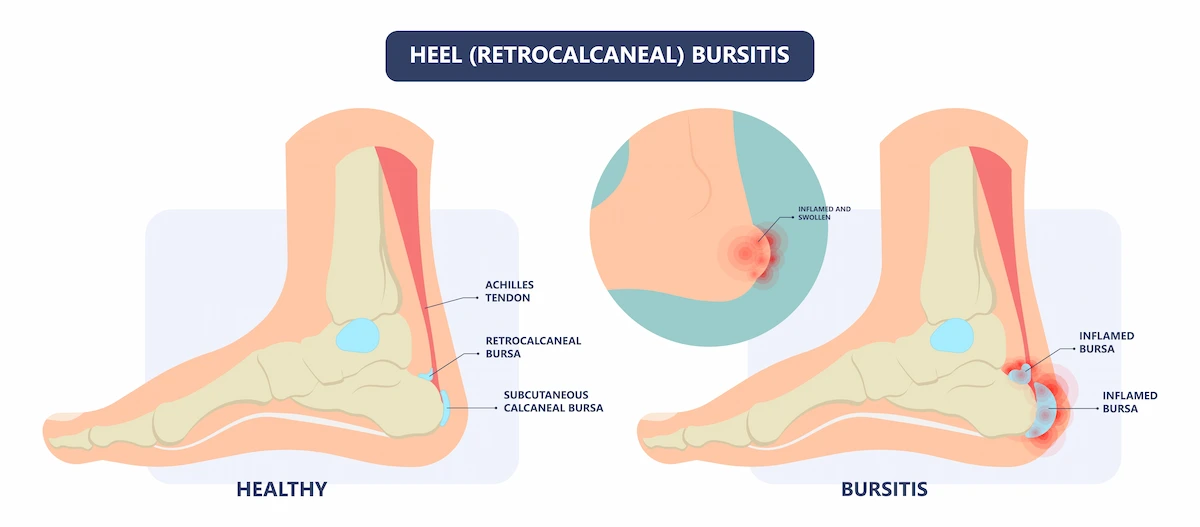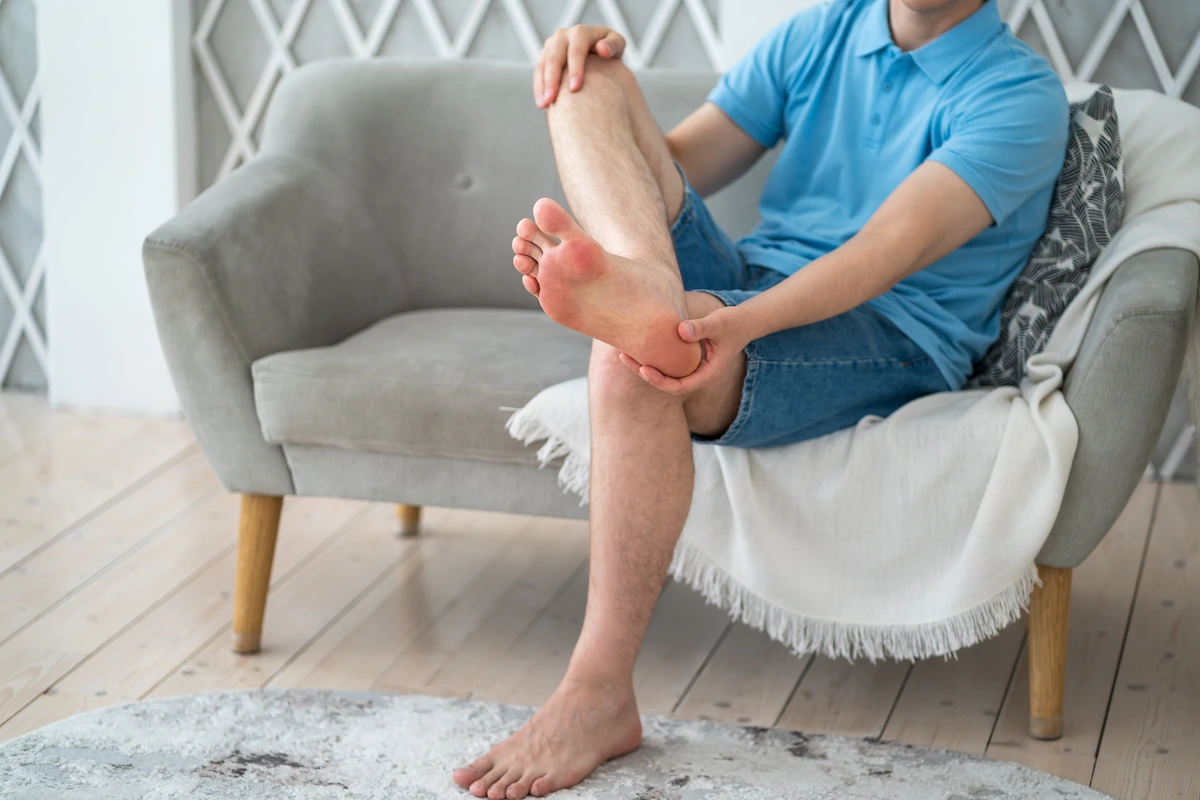Achilles Bursitis: Understanding Heel Pain in Miami

Heel pain can significantly impact your mobility and daily activities, especially in a place like Miami, where an active lifestyle is so prevalent. If you’re experiencing pain, swelling, or tenderness at the back of your heel, you might be dealing with Achilles bursitis.
This article will help you understand what Achilles bursitis is, its causes, symptoms, and treatment options, empowering you to seek appropriate care and get back on your feet.
What is Bursitis?
Bursae are small, fluid-filled sacs located near joints throughout your body. They act as cushions, reducing friction between bones, tendons, and muscles during movement. Bursitis occurs when these bursae become inflamed, causing pain and swelling.
Achilles Bursitis: Inflammation at the Heel
Achilles bursitis specifically affects the bursa located at the back of the heel, where the Achilles tendon (the large tendon connecting your calf muscles to your heel bone) attaches. This bursa, known as the retrocalcaneal bursa, can become inflamed due to overuse, injury, or other factors.
Bursitis Heel: Recognizing the Symptoms
Symptoms of Achilles bursitis can include:
- Pain at the back of the heel: This pain often worsens with activity, such as walking, running, or standing on your toes.
- Swelling and tenderness: You might notice visible swelling or a soft lump on the back of your heel.
- Stiffness: The back of your heel might feel stiff, especially in the morning or after rest.
- Warmth and redness: The area might feel warm to the touch and appear red.
Retrocalcaneal Bursitis: A More Specific Term
Retrocalcaneal bursitis is another term for Achilles bursitis, specifically referring to the inflammation of the bursa located between the Achilles tendon and the heel bone (calcaneus).

Causes of Achilles Bursitis
Several factors can contribute to Achilles bursitis:
- Overuse or repetitive strain: Activities that involve repetitive ankle movements, such as running, jumping, or prolonged standing, can irritate the bursa.
- Tight shoes: Shoes that are too tight or rub against the back of your heel can cause friction and inflammation.
- Heel bone spurs: Bony growths on the heel bone can irritate the bursa.
- Arthritis: Inflammatory conditions like rheumatoid arthritis can affect the bursa.
- Injury: A direct blow to the back of the heel can also cause bursitis.
Treatment for Achilles Bursitis: Finding Relief
Treatment for Achilles bursitis aims to reduce inflammation and relieve pain. Options include:
- Rest: Avoid activities that worsen your pain.
- Ice: Apply ice packs to the back of your heel for 15-20 minutes at a time to reduce swelling.
- Elevation: Elevate your leg to help reduce swelling.
- Over-the-counter pain relievers: Medications like ibuprofen or naproxen can help reduce pain and inflammation.
- Stretching and exercises: Gentle stretches and exercises can help improve ankle flexibility and strengthen the surrounding muscles.
- Orthotics: Shoe inserts can help support your foot and ankle and reduce stress on the Achilles tendon and bursa.
- Injections: In some cases, your doctor might recommend a cortisone injection to reduce inflammation.
- Surgery: Surgery is rarely necessary, but it might be considered if other treatments fail.
Primary Doctor in Miami: Your First Step to Relief
If you’re experiencing heel pain and suspect you might have Achilles bursitis, it’s essential to consult a primary doctor in Miami. They can:
- Evaluate your symptoms and medical history.
- Perform a physical exam to assess your heel and ankle.
- Order X-rays or other imaging tests, if necessary, to rule out other conditions.
- Recommend appropriate treatment options and provide guidance on managing your pain.
Key Takeaways:
- Achilles bursitis is inflammation of the bursa at the back of the heel.
- Symptoms include pain, swelling, and tenderness at the back of the heel.
- Treatment options range from rest and ice to injections or, rarely, surgery.
- Consult a primary doctor in Miami for diagnosis and treatment.
Remember, this article is for informational purposes only and should not be considered a substitute for professional medical advice. If you have any concerns about your health or are experiencing heel pain, consult a qualified healthcare professional.
FAQs: Achilles Bursitis
- How can I tell if my heel pain is from Achilles bursitis or Achilles tendonitis?
Achilles bursitis typically causes pain and swelling at the back of the heel, where the Achilles tendon inserts. Achilles tendonitis causes pain along the Achilles tendon itself, often worsening with activity. Your doctor can perform a physical exam to differentiate between these conditions. - Can I still exercise if I have Achilles bursitis?
It’s generally recommended to avoid activities that worsen your pain. Low-impact exercises like swimming or cycling might be tolerated, but rest is often crucial for healing. Consult your doctor or a physical therapist in Miami for personalized exercise recommendations. - Are there any specific shoes that are better for Achilles bursitis?
Shoes with good heel support and cushioning can help reduce irritation. Avoid shoes with tight heel counters or those that rub against the back of your heel. Your doctor or a shoe specialist can offer personalized footwear advice. - How long does it take for Achilles bursitis to heal?
Healing time varies depending on the severity of the condition and the treatment approach. With rest, ice, and other conservative measures, symptoms often improve within a few weeks. However, chronic cases might take longer to heal. - I’m experiencing a soft lump on the back of my heel. Is this definitely Achilles bursitis?
A soft lump on the back of the heel is a common symptom of Achilles bursitis. However, other conditions, like a bone spur or a cyst, can also cause similar symptoms. It’s important to consult a doctor in Miami for a proper diagnosis and treatment plan.
Contact Us
Hiriart & Lopez MD, LLC
9950 SW 107th Ave STE 101,
Miami, FL 33176
305-274-8779
Phone: (305) 274-8779
Fax: (305) 274-0646
OPENING HOURS
Monday 7:30 AM–4:30 PM
Tuesday 7:30 AM–4:30 PM
Wednesday 7:30 AM–4:30 PM
Thursday 7:30 AM–4:30 PM
Friday 7:30–11 AM
Saturday Closed
Sunday Closed
OFFICE LOCATION
Achilles Bursitis: Understanding Heel Pain in Miami

Heel pain can significantly impact your mobility and daily activities, especially in a place like Miami, where an active lifestyle is so prevalent. If you’re experiencing pain, swelling, or tenderness at the back of your heel, you might be dealing with Achilles bursitis.
This article will help you understand what Achilles bursitis is, its causes, symptoms, and treatment options, empowering you to seek appropriate care and get back on your feet.
What is Bursitis?
Bursae are small, fluid-filled sacs located near joints throughout your body. They act as cushions, reducing friction between bones, tendons, and muscles during movement. Bursitis occurs when these bursae become inflamed, causing pain and swelling.
Achilles Bursitis: Inflammation at the Heel
Achilles bursitis specifically affects the bursa located at the back of the heel, where the Achilles tendon (the large tendon connecting your calf muscles to your heel bone) attaches. This bursa, known as the retrocalcaneal bursa, can become inflamed due to overuse, injury, or other factors.
Bursitis Heel: Recognizing the Symptoms
Symptoms of Achilles bursitis can include:
- Pain at the back of the heel: This pain often worsens with activity, such as walking, running, or standing on your toes.
- Swelling and tenderness: You might notice visible swelling or a soft lump on the back of your heel.
- Stiffness: The back of your heel might feel stiff, especially in the morning or after rest.
- Warmth and redness: The area might feel warm to the touch and appear red.
Retrocalcaneal Bursitis: A More Specific Term
Retrocalcaneal bursitis is another term for Achilles bursitis, specifically referring to the inflammation of the bursa located between the Achilles tendon and the heel bone (calcaneus).

Causes of Achilles Bursitis
Several factors can contribute to Achilles bursitis:
- Overuse or repetitive strain: Activities that involve repetitive ankle movements, such as running, jumping, or prolonged standing, can irritate the bursa.
- Tight shoes: Shoes that are too tight or rub against the back of your heel can cause friction and inflammation.
- Heel bone spurs: Bony growths on the heel bone can irritate the bursa.
- Arthritis: Inflammatory conditions like rheumatoid arthritis can affect the bursa.
- Injury: A direct blow to the back of the heel can also cause bursitis.
Treatment for Achilles Bursitis: Finding Relief
Treatment for Achilles bursitis aims to reduce inflammation and relieve pain. Options include:
- Rest: Avoid activities that worsen your pain.
- Ice: Apply ice packs to the back of your heel for 15-20 minutes at a time to reduce swelling.
- Elevation: Elevate your leg to help reduce swelling.
- Over-the-counter pain relievers: Medications like ibuprofen or naproxen can help reduce pain and inflammation.
- Stretching and exercises: Gentle stretches and exercises can help improve ankle flexibility and strengthen the surrounding muscles.
- Orthotics: Shoe inserts can help support your foot and ankle and reduce stress on the Achilles tendon and bursa.
- Injections: In some cases, your doctor might recommend a cortisone injection to reduce inflammation.
- Surgery: Surgery is rarely necessary, but it might be considered if other treatments fail.
Primary Doctor in Miami: Your First Step to Relief
If you’re experiencing heel pain and suspect you might have Achilles bursitis, it’s essential to consult a primary doctor in Miami. They can:
- Evaluate your symptoms and medical history.
- Perform a physical exam to assess your heel and ankle.
- Order X-rays or other imaging tests, if necessary, to rule out other conditions.
- Recommend appropriate treatment options and provide guidance on managing your pain.
Key Takeaways:
- Achilles bursitis is inflammation of the bursa at the back of the heel.
- Symptoms include pain, swelling, and tenderness at the back of the heel.
- Treatment options range from rest and ice to injections or, rarely, surgery.
- Consult a primary doctor in Miami for diagnosis and treatment.
Remember, this article is for informational purposes only and should not be considered a substitute for professional medical advice. If you have any concerns about your health or are experiencing heel pain, consult a qualified healthcare professional.
FAQs: Achilles Bursitis
- How can I tell if my heel pain is from Achilles bursitis or Achilles tendonitis?
Achilles bursitis typically causes pain and swelling at the back of the heel, where the Achilles tendon inserts. Achilles tendonitis causes pain along the Achilles tendon itself, often worsening with activity. Your doctor can perform a physical exam to differentiate between these conditions. - Can I still exercise if I have Achilles bursitis?
It’s generally recommended to avoid activities that worsen your pain. Low-impact exercises like swimming or cycling might be tolerated, but rest is often crucial for healing. Consult your doctor or a physical therapist in Miami for personalized exercise recommendations. - Are there any specific shoes that are better for Achilles bursitis?
Shoes with good heel support and cushioning can help reduce irritation. Avoid shoes with tight heel counters or those that rub against the back of your heel. Your doctor or a shoe specialist can offer personalized footwear advice. - How long does it take for Achilles bursitis to heal?
Healing time varies depending on the severity of the condition and the treatment approach. With rest, ice, and other conservative measures, symptoms often improve within a few weeks. However, chronic cases might take longer to heal. - I’m experiencing a soft lump on the back of my heel. Is this definitely Achilles bursitis?
A soft lump on the back of the heel is a common symptom of Achilles bursitis. However, other conditions, like a bone spur or a cyst, can also cause similar symptoms. It’s important to consult a doctor in Miami for a proper diagnosis and treatment plan.
Contact Us
Hiriart & Lopez MD, LLC
9950 SW 107th Ave STE 101,
Miami, FL 33176
305-274-8779
Phone: (305) 274-8779
Fax: (305) 274-0646
OPENING HOURS
Monday 7:30 AM–4:30 PM
Tuesday 7:30 AM–4:30 PM
Wednesday 7:30 AM–4:30 PM
Thursday 7:30 AM–4:30 PM
Friday 7:30–11 AM
Saturday Closed
Sunday Closed

